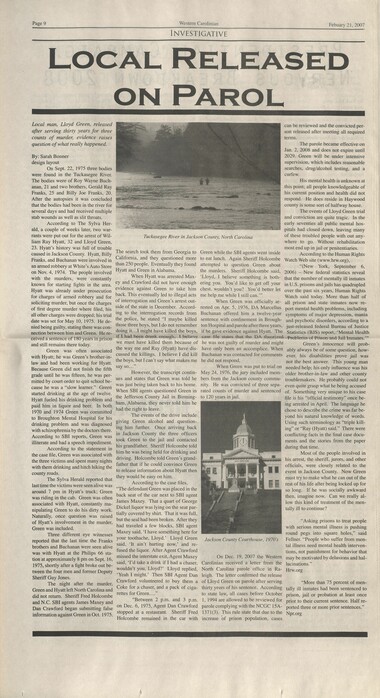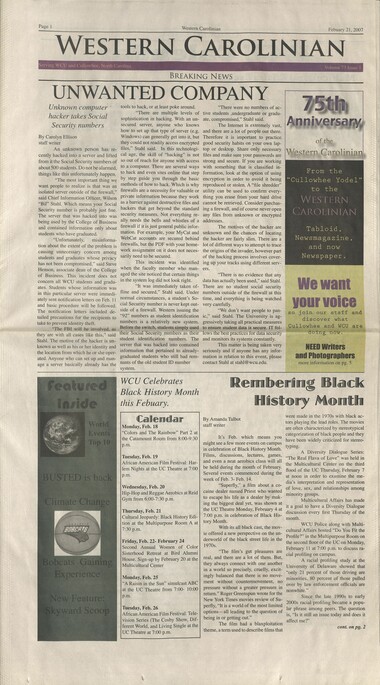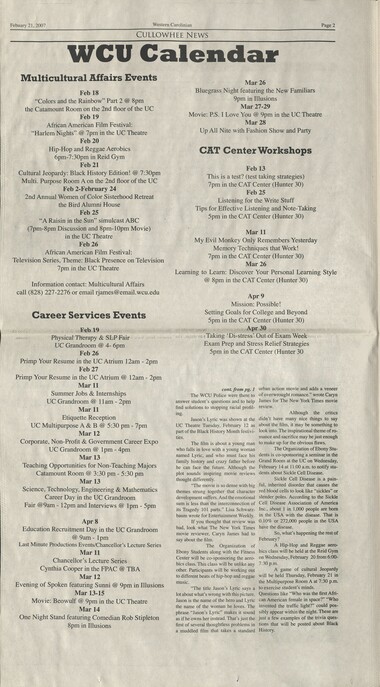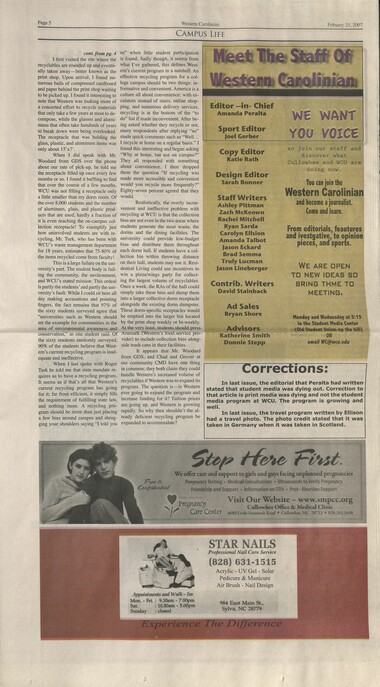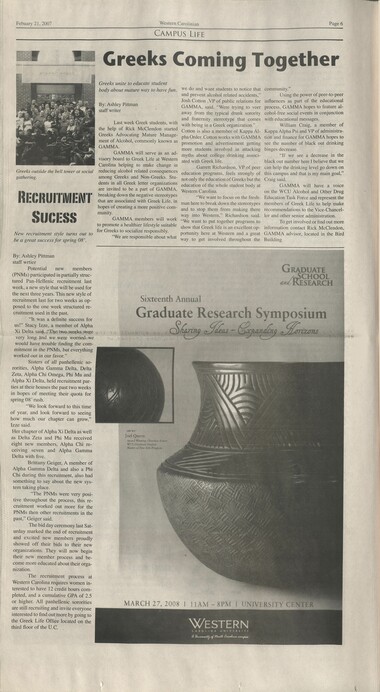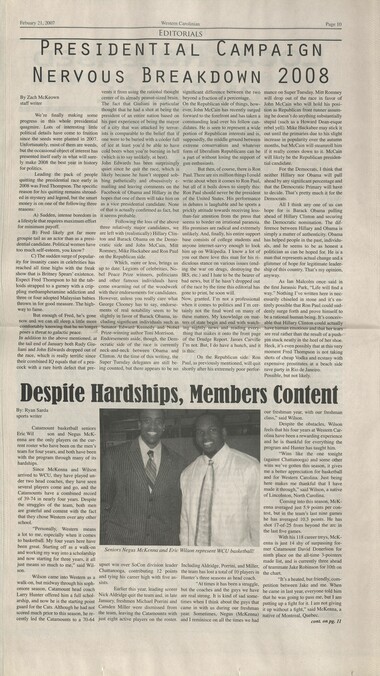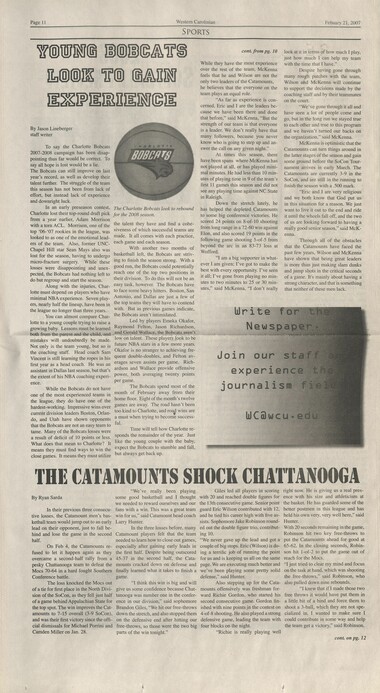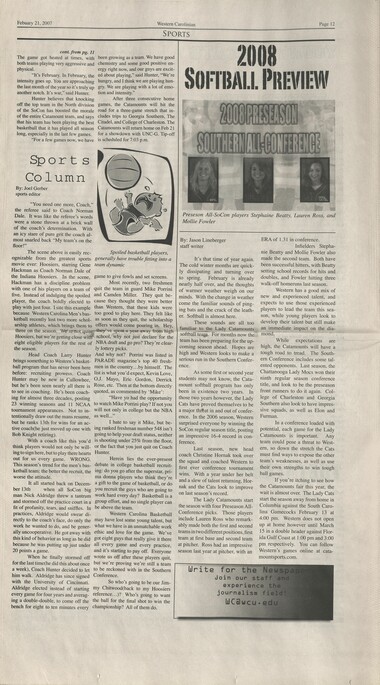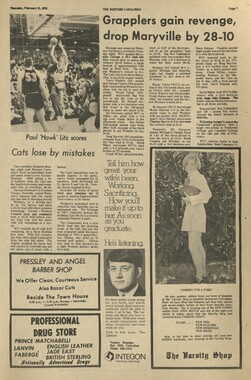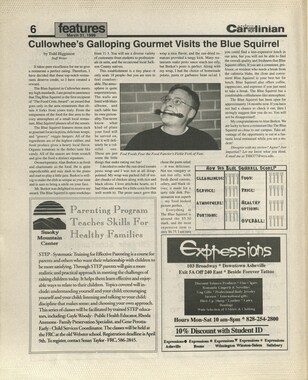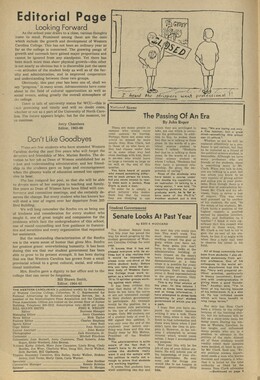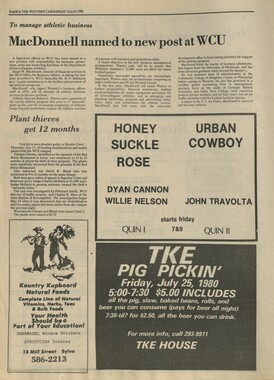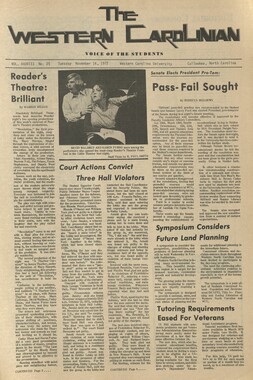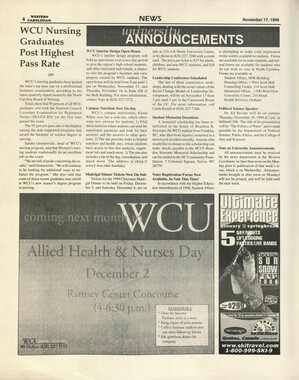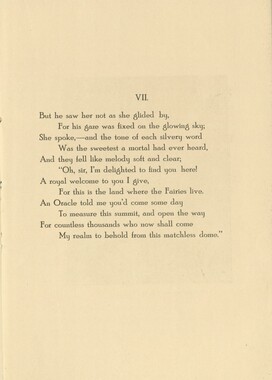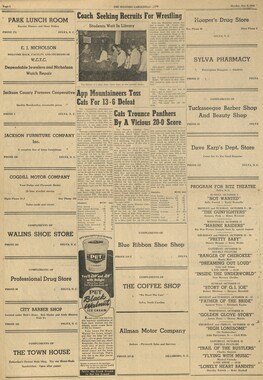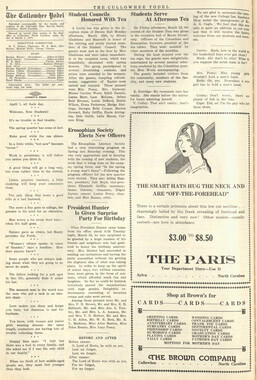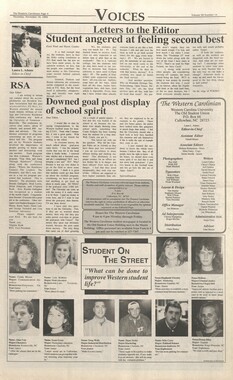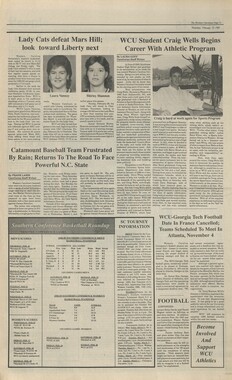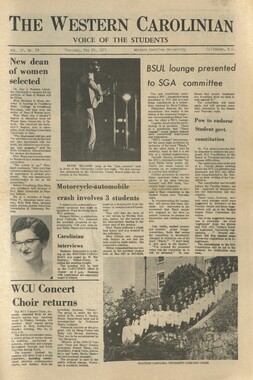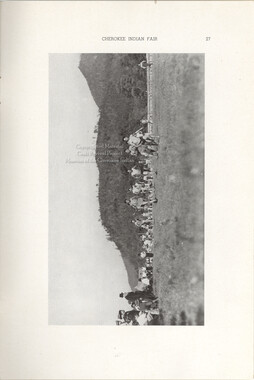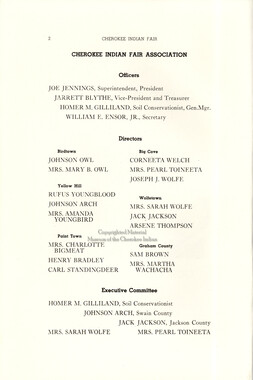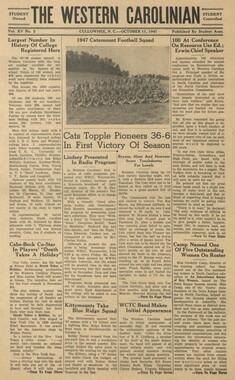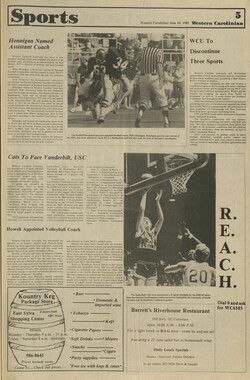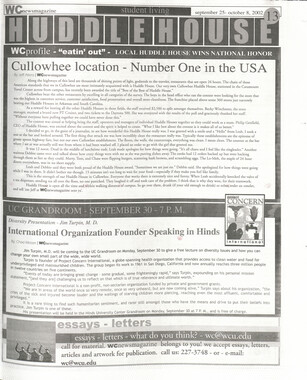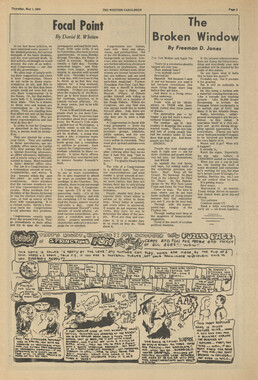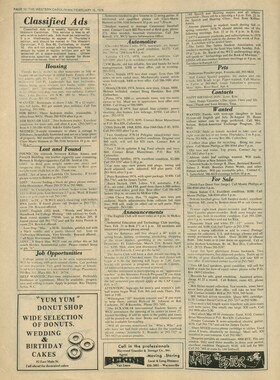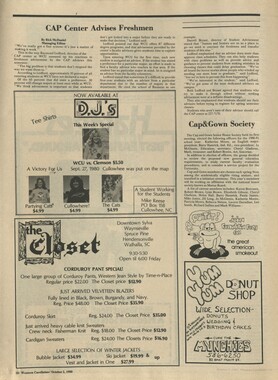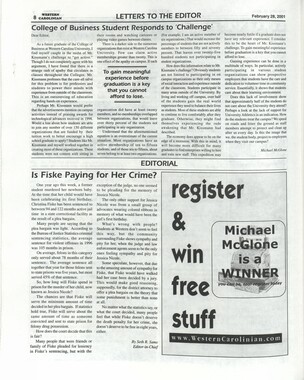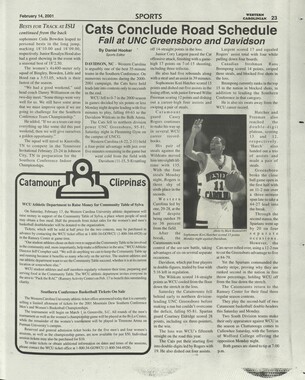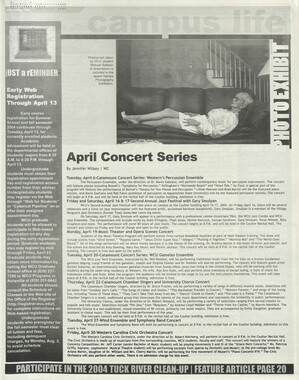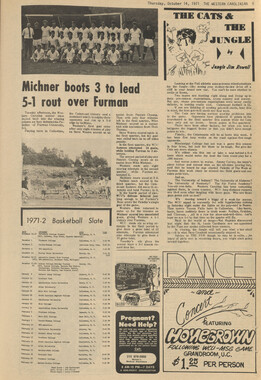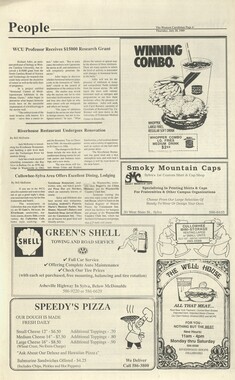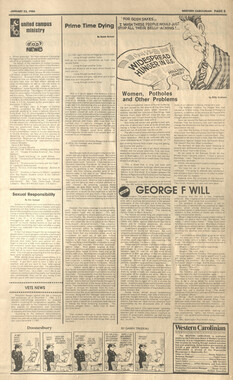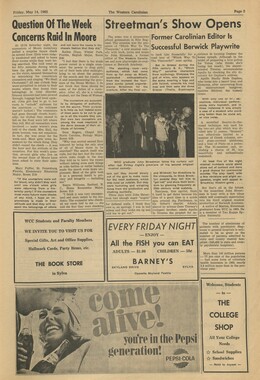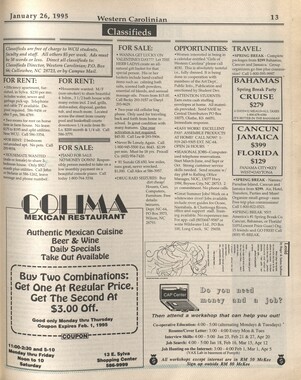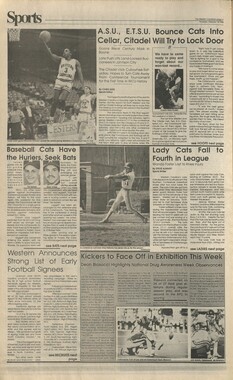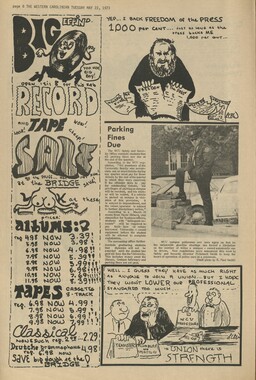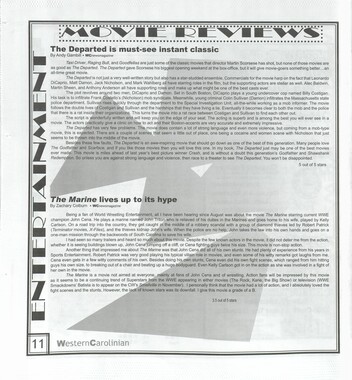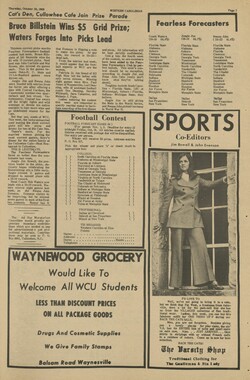Western Carolina University (20)
View all
- Canton Champion Fibre Company (2308)
- Cherokee Traditions (291)
- Civil War in Southern Appalachia (165)
- Craft Revival (1942)
- Great Smoky Mountains - A Park for America (2946)
- Highlights from Western Carolina University (430)
- Horace Kephart (941)
- Journeys Through Jackson (159)
- LGBTQIA+ Archive of Jackson County (85)
- Oral Histories of Western North Carolina (314)
- Picturing Appalachia (6873)
- Stories of Mountain Folk (413)
- Travel Western North Carolina (160)
- Western Carolina University Fine Art Museum Vitreograph Collection (129)
- Western Carolina University Herbarium (92)
- Western Carolina University: Making Memories (738)
- Western Carolina University Publications (2488)
- Western Carolina University Restricted Electronic Theses and Dissertations (146)
- Western North Carolina Regional Maps (71)
- World War II in Southern Appalachia (131)
University of North Carolina Asheville (6)
View all
- Allanstand Cottage Industries (62)
- Appalachian National Park Association (53)
- Bennett, Kelly, 1890-1974 (1463)
- Berry, Walter (76)
- Brasstown Carvers (40)
- Carver, George Washington, 1864?-1943 (26)
- Cathey, Joseph, 1803-1874 (1)
- Champion Fibre Company (233)
- Champion Paper and Fibre Company (297)
- Cherokee Indian Fair Association (16)
- Cherokee Language Program (22)
- Crowe, Amanda (40)
- Edmonston, Thomas Benton, 1842-1907 (7)
- Ensley, A. L. (Abraham Lincoln), 1865-1948 (275)
- Fromer, Irving Rhodes, 1913-1994 (70)
- George Butz (BFS 1907) (46)
- Goodrich, Frances Louisa (120)
- Grant, George Alexander, 1891-1964 (96)
- Heard, Marian Gladys (60)
- Kephart, Calvin, 1883-1969 (15)
- Kephart, Horace, 1862-1931 (313)
- Kephart, Laura, 1862-1954 (39)
- Laney, Gideon Thomas, 1889-1976 (439)
- Masa, George, 1881-1933 (61)
- McElhinney, William Julian, 1896-1953 (44)
- Niggli, Josephina, 1910-1983 (10)
- North Carolina Park Commission (105)
- Osborne, Kezia Stradley (9)
- Owens, Samuel Robert, 1918-1995 (11)
- Penland Weavers and Potters (36)
- Roberts, Vivienne (15)
- Roth, Albert, 1890-1974 (142)
- Schenck, Carl Alwin, 1868-1955 (1)
- Sherrill's Photography Studio (2565)
- Southern Highland Handicraft Guild (127)
- Southern Highlanders, Inc. (71)
- Stalcup, Jesse Bryson (46)
- Stearns, I. K. (213)
- Thompson, James Edward, 1880-1976 (226)
- United States. Indian Arts and Crafts Board (130)
- USFS (683)
- Vance, Zebulon Baird, 1830-1894 (1)
- Weaver, Zebulon, 1872-1948 (58)
- Western Carolina College (230)
- Western Carolina Teachers College (282)
- Western Carolina University (2005)
- Western Carolina University. Mountain Heritage Center (18)
- Whitman, Walt, 1819-1892 (10)
- Wilburn, Hiram Coleman, 1880-1967 (73)
- Williams, Isadora (3)
- Cain, Doreyl Ammons (0)
- Crittenden, Lorraine (0)
- Rhodes, Judy (0)
- Smith, Edward Clark (0)
- Appalachian Region, Southern (2569)
- Asheville (N.C.) (1923)
- Avery County (N.C.) (26)
- Blount County (Tenn.) (195)
- Buncombe County (N.C.) (1672)
- Cherokee County (N.C.) (283)
- Clay County (N.C.) (555)
- Graham County (N.C.) (236)
- Great Smoky Mountains National Park (N.C. and Tenn.) (519)
- Haywood County (N.C.) (3569)
- Henderson County (N.C.) (70)
- Jackson County (N.C.) (4909)
- Knox County (Tenn.) (35)
- Knoxville (Tenn.) (13)
- Lake Santeetlah (N.C.) (10)
- Macon County (N.C.) (420)
- Madison County (N.C.) (215)
- McDowell County (N.C.) (39)
- Mitchell County (N.C.) (132)
- Polk County (N.C.) (35)
- Qualla Boundary (982)
- Rutherford County (N.C.) (76)
- Swain County (N.C.) (2182)
- Transylvania County (N.C.) (270)
- Watauga County (N.C.) (12)
- Waynesville (N.C.) (86)
- Yancey County (N.C.) (72)
- Aerial Photographs (3)
- Aerial Views (60)
- Albums (books) (4)
- Articles (1)
- Artifacts (object Genre) (228)
- Bibliographies (1)
- Biography (general Genre) (2)
- Cards (information Artifacts) (38)
- Clippings (information Artifacts) (191)
- Copybooks (instructional Materials) (3)
- Crafts (art Genres) (622)
- Depictions (visual Works) (21)
- Design Drawings (1)
- Drawings (visual Works) (185)
- Envelopes (73)
- Exhibitions (events) (1)
- Facsimiles (reproductions) (1)
- Fiction (general Genre) (4)
- Financial Records (12)
- Fliers (printed Matter) (67)
- Glass Plate Negatives (381)
- Guidebooks (2)
- Internegatives (10)
- Interviews (815)
- Land Surveys (102)
- Letters (correspondence) (1013)
- Manuscripts (documents) (618)
- Maps (documents) (177)
- Memorandums (25)
- Minutes (administrative Records) (59)
- Negatives (photographs) (6090)
- Newsletters (1290)
- Newspapers (2)
- Notebooks (8)
- Occupation Currency (1)
- Paintings (visual Works) (1)
- Pen And Ink Drawings (1)
- Periodicals (193)
- Personal Narratives (10)
- Photographs (12976)
- Plans (maps) (1)
- Poetry (5)
- Portraits (4568)
- Postcards (329)
- Programs (documents) (181)
- Publications (documents) (2440)
- Questionnaires (65)
- Relief Prints (26)
- Sayings (literary Genre) (1)
- Scrapbooks (282)
- Sheet Music (2)
- Slides (photographs) (402)
- Songs (musical Compositions) (2)
- Sound Recordings (796)
- Specimens (92)
- Speeches (documents) (18)
- Tintypes (photographs) (8)
- Transcripts (322)
- Video Recordings (physical Artifacts) (23)
- Text Messages (0)
- A.L. Ensley Collection (275)
- Appalachian Industrial School Records (7)
- Appalachian National Park Association Records (336)
- Axley-Meroney Collection (2)
- Bayard Wootten Photograph Collection (20)
- Bethel Rural Community Organization Collection (7)
- Blumer Collection (5)
- C.W. Slagle Collection (20)
- Canton Area Historical Museum (2110)
- Carlos C. Campbell Collection (462)
- Cataloochee History Project (64)
- Cherokee Studies Collection (4)
- Daisy Dame Photograph Album (5)
- Daniel Boone VI Collection (1)
- Doris Ulmann Photograph Collection (112)
- Elizabeth H. Lasley Collection (1)
- Elizabeth Woolworth Szold Fleharty Collection (4)
- Frank Fry Collection (95)
- George Masa Collection (173)
- Gideon Laney Collection (452)
- Hazel Scarborough Collection (2)
- Hiram C. Wilburn Papers (28)
- Historic Photographs Collection (236)
- Horace Kephart Collection (861)
- Humbard Collection (33)
- Hunter and Weaver Families Collection (1)
- I. D. Blumenthal Collection (4)
- Isadora Williams Collection (4)
- Jesse Bryson Stalcup Collection (47)
- Jim Thompson Collection (224)
- John B. Battle Collection (7)
- John C. Campbell Folk School Records (80)
- John Parris Collection (6)
- Judaculla Rock project (2)
- Kelly Bennett Collection (1482)
- Love Family Papers (11)
- Major Wiley Parris Civil War Letters (3)
- Map Collection (12)
- McFee-Misemer Civil War Letters (34)
- Mountain Heritage Center Collection (4)
- Norburn - Robertson - Thomson Families Collection (44)
- Pauline Hood Collection (7)
- Pre-Guild Collection (2)
- Qualla Arts and Crafts Mutual Collection (12)
- R.A. Romanes Collection (681)
- Rosser H. Taylor Collection (1)
- Samuel Robert Owens Collection (94)
- Sara Madison Collection (144)
- Sherrill Studio Photo Collection (2558)
- Smoky Mountains Hiking Club Collection (616)
- Stories of Mountain Folk - Radio Programs (374)
- The Reporter, Western Carolina University (510)
- Venoy and Elizabeth Reed Collection (16)
- WCU Gender and Sexuality Oral History Project (32)
- WCU Mountain Heritage Center Oral Histories (25)
- WCU Oral History Collection - Mountain People, Mountain Lives (71)
- WCU Students Newspapers Collection (1920)
- Western North Carolina Tomorrow Black Oral History Project (69)
- William Williams Stringfield Collection (2)
- Zebulon Weaver Collection (109)
- African Americans (390)
- Appalachian Trail (35)
- Artisans (521)
- Cherokee art (84)
- Cherokee artists -- North Carolina (10)
- Cherokee language (21)
- Cherokee pottery (101)
- Cherokee women (208)
- Church buildings (189)
- Civilian Conservation Corps (U.S.) (111)
- College student newspapers and periodicals (2009)
- Dams (107)
- Dance (1023)
- Education (222)
- Floods (61)
- Folk music (1015)
- Forced removal, 1813-1903 (2)
- Forest conservation (220)
- Forests and forestry (1184)
- Gender nonconformity (4)
- Great Smoky Mountains National Park (N.C. and Tenn.) (181)
- Hunting (45)
- Landscape photography (25)
- Logging (119)
- Maps (83)
- Mines and mineral resources (8)
- North Carolina -- Maps (18)
- Paper industry (38)
- Postcards (255)
- Pottery (135)
- Railroad trains (72)
- Rural electrification -- North Carolina, Western (3)
- School integration -- Southern States (2)
- Segregation -- North Carolina, Western (5)
- Slavery (5)
- Sports (452)
- Storytelling (243)
- Waterfalls -- Great Smoky Mountains (N.C. and Tenn.) (66)
- Weaving -- Appalachian Region, Southern (280)
- Wood-carving -- Appalachian Region, Southern (328)
- World War, 1939-1945 (173)
Western Carolinian Volume 73 Number 01
Item
Item’s are ‘child’ level descriptions to ‘parent’ objects, (e.g. one page of a whole book).
-
-
Page 9 _Western Caroli inian Febuary 21, 2007 Sie. ore LOCAL Rei BASED ON PAROL Local man, Lloyd Green, released after serving thirty years for three counts of murder, evidence raises question of what really happened. By: Sarah Bonner design layout On Sept. 22, 1975 three bodies were found in the Tuckasegee River. The bodies were of Roy Wayne Buch- anan, 21 and two brothers, Gerald Ray Franks, 25 and Billy Joe Franks, 20. After the autopsies it was concluded that the bodies had been in the river for several days and had received multiple stab wounds as well as slit throats. According to The Sylva Her- ald, a couple of weeks later, two war- rants were put out for the arrest of Wil- liam Ray Hyatt, 32 and Lloyd Green, 23. Hyatts history was full of trouble caused in Jackson County. Hyatt, Billy Franks, and Buchanan were involved in an armed robbery at Whites Auto Store on Nov. 4, 1974. The people involved with the murders, were constantly known for starting fights in the area. Hyatt was already under prosecution for charges of armed robbery and for soliciting murder, but once the charges of first degree murder where filed, his all other charges were dropped; his trial date was set for May 10, 1975. He de- nied being guilty, stating there was con- nection between him and Green. He re-.. ceived a sentence of 180 years in prison and still remains there today. Green was often associated with Hyatt; he was Greens brother-in- law and had been working for Hyatt. Because Green did not finish the fifth grade until he was fifteen, he was per- mitted by court order to quit school be- cause he was a slow learner. Green started drinking at the age of twelve. Hyatt fueled his drinking problem and paid him in liquor and beer. In both 1970 and 1974 Green was committed to Broughton Mental Hospital for his drinking problem and was diagnosed with schizophrenia by the doctors there. According to SBI reports, Green was illiterate and had a speech impediment. According to the statement in the case file, Green was associated with the three victims and spent many nights with them drinking and hitch hiking the county roads. The Sylva Herald reported that last time the victims were seen alive was around 7 pm in Hyatts truck; Green was riding in the cab. Green was often associated with Hyatt, constantly ma- nipulating Green to do his dirty work. Naturally, once question was raised of Hyatts involvement in the murder, Green was included. Three different eye witnesses reported that the last time the Franks brothers and Buchanan were seen alive was with Hyatt at the Philips 66 sta- tion at approximately 8 pm on Sept. 16, 1975, shortly after a fight broke out be- tween the four men and former Deputy Sheriff Guy Jones. The night after the murder, Green and Hyatt left North Carolina and did not return. Sheriff Fred Holcombe and N.C. SBI agents James Maxey and Dan Crawford began submitting false information against Green in Oct. 1975. Tuckasegee River in Jackson County, North Carolina The search took them from Georgia to California, and they questioned more than 250 people. Eventually they found Hyatt and Green in Alabama. When Hyatt was arrested Max- ey and Crawford did not have enough evidence against Green to take him back. This eventually led to illegal acts of interrogation and Greens arrest out- side of the state in December. Accord- ing to the interrogation records from the police, he stated I maybe killed those three boys, but I do not remember doing it...I might have killed the boys, if Thad been drunk. enough. 1 believe we must have killed them because of the way me and Ray (Hyatt) have dis- cussed the killings. I believe I did kill the boys, but I cant say what makes me say so... However, the transcript contin- ues and states that Green was told he was just being taken back to his home. When SBI agents questioned Green in the Jefferson County Jail in Birming- ham, Alabama, they never told him he had the right to leave. The events of the drive include giving Green alcohol and question- ing him further. Once arriving back in Jackson County the three officers took Green to the jail and contacted his grandfather. Sheriff Holcombe told him he was being held for drinking and driving. Holcombe told Greens grand- father that if he could convince Green to release information about Hyatt then they would be easy on him. According to the case files, The defendant Green was placed in the back seat of the car next to SBI agent James Maxey. That a quart of George Dickel liquor was lying on the seat par- tially covered by shirt. That it was full, but the seal had been broken. After they had traveled a few blocks, SBI agent Maxey said, I have something here for your toothache, Lloyd. Lloyd Green said, It aint hurting now, and re- fused the liquor. After Agent Crawford missed the interstate exit, Agent Maxey said, Id take a drink if I had a chaser, wouldnt you, Lloyd? Lloyd replied, Yeah I might. Then SBI Agent Dan Crawford volunteered to buy them a Coke for a chaser, ae a pack of ciga- rettes for Green.. Betweotl, 2 p.m. and 3 p.m. on Dec. 6, 1975, Agent Dan Crawford stopped at a restaurant. Sheriff Fred Holcombe remained in the car with Green while the SBI agents went inside to eat lunch. Again Sheriff Holcombe attempted to question Green about the murders. Sheriff Holcombe said, Lloyd, I believe something is both- ering you. Youd like to get off your chest, wouldnt you? You'd better let me help me while I still can. When Green was officially ar- rested on Apr. 5, 1976, DA Marcellus Buchanan offered him a twelve-year can be reviewed and the convicted per- son released after meeting all required terms. The parole became effective on Jan. 2, 2008 and does not expire until 2029. Green will be under intensive supervision, which includes reasonable searches, drug/alcohol testing, and a curfew. His mental health is unknown at this point; all people knowledgeable of his current position and health did not respond. He does reside in Haywood county is some sort of halfway house. The events of Lloyd Green trial and conviction are quite tragic. In the early seventies all public mental hos- pitals had closed down, leaving many of these troubled people with out any- where to go. Without rehabilitation most end up in jail or penitentiaries. According to the Human Rights Watch Web site (www.hrw.org), (New York, September 6, 2006) New federal statistics reveal that the number of mentally ill inmates in U.S. prisons and jails has quadrupled over the past six years, Human Rights Watch said today. More than half of all prison and state inmates now re- port mental health problems, including symptoms of major depression, mania sentence with confinement in Brough- and psychotic disorders, according to a ton Hospital and parole after three years, just-released federal Bureau of Justice _ if he gave evidence against Hyatt. The Statistics(BJS) report, Mental Health case file states that the DA. theorized. .sProblems) of Prison'and Jail Inmates. he was not guilty of murder and might Greens innocence will prob- have only been an accomplice. When ably always be of some question, how- Buchanan was contacted for comments eyer, his disabilities prove jail was he did not respond. not the best answer. This young man When Green was put to trialon needed help; his only influence was his May 24, 1976, the jury included mem- oJder brother-in-law and other county bers from the Jackson county commu- troublemakers. He probably could not nity. He was convicted of three sepa- eyen quite grasp what he being accused rated counts of murder and sentenced of, Something very unique to his case to 120 years in jail. file is his official testimony once be- ing arrested in April. The language he chose to describe the crime was far be- yond his natural knowledge of words. Using such terminology as triple kill- ing or Ray (Hyatt) said. There were conflicting facts in the final case docu- ments and the stories from the ee during that time. Most of the people involved in his arrest, the sheriff, jurors, and other officials, were closely related to the event in Jackson County. Now Green must try to make what he can out of the rest of his life after being locked up for so long. If he was socially awkward then, imagine now. Can we really al- low this kind of treatment of the men- tally ill to continue? Asking prisons to treat people with serious mental illness is pushing round pegs into square holes, said Fellner. People who suffer from men- tal illness need mental health interven- tions, not punishment for behavior that may be motivated by delusions and hal- lucinations. Hrw.org Jackson County Courthouse, 1970's On Dec. 19, 2007 the Western Carolinian received a letter from the North Carolina parole office in Ra- leigh. The letter confirmed the release of Lloyd Green on parole after serving thirty years of his sentence. According to state law, all cases before October 1, 1994 are allowed to be reviewed for parole complying with the NCGC 15A- 1371(3). This rule state that due to the increase of prison population, cases More than 75 percent of men- tally ill inmates had been sentenced to prison, jail or probation at least once prior to their current sentence. Half re- ported three or more prior sentences. Npr.org
Object
Object’s are ‘parent’ level descriptions to ‘children’ items, (e.g. a book with pages).
-
The Western Carolinian is Western Carolina University's student-run newspaper. The paper was published as the Cullowhee Yodel from 1924 to 1931 before changing its name to The Western Carolinian in 1933.
-
